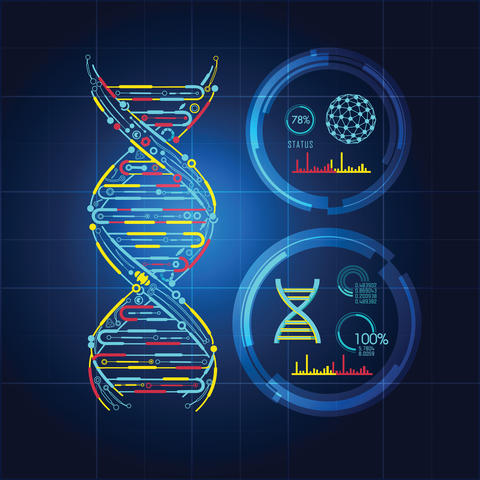Summary
The accurate mass determination of DNA and other nucleic acids is of critical importance in many clinical diagnoses and in forensic and molecular biological studies. In addition, these measurements could aid in the determination of transgenic material in agricultural and food products. NIST is currently developing inductively coupled plasma optical emission spectrometry (ICP-OES) methodology that allows for the mass of DNA to be traceable to the SI. This method, if successful, will aide in the development of Standard Reference Materials (SRMs) with certified nucleic acid content.
Description

The biotechnology industry relies primarily on absorbance and fluorescence methodologies to assess DNA mass. However, these measurements can be seriously compromised by impurities in the DNA preparations or state of the DNA itself. These techniques are also not traceable to the SI because the calibrations cannot currently be performed using calibration standards whose values are traceable to the SI. Such techniques cannot achieve the high accuracy and precision required to produce SRMs for nucleic acid materials.
At NIST in collaboration with The George Washington University (GWU), a methodology that can be used to provide accurate measurements of DNA and nucleic acid mass that are traceable to the SI is being developed with the long-term goal of providing an SRM for DNA mass. Currently, the ICP-OES approach developed at NIST, referred to as high-performance ICP-OES (HP-ICP-OES) incorporating a ratio-based technique with drift correction, has been utilized for the measurement of phosphorus content of acid-digested nucleotides and DNA. The HP-ICP-OES measurement of phosphorus provides a highly accurate quantification of mass for both nucleotide monophosphate and DNA with relative uncertainties less than 0.1 % (95 % confidence level). However, the current approach requires a significant sample size (10 mL of solution containing a DNA concentration of 50 μg/mL), restricting its usefulness for the quantification of DNA. A demountable, direct-injection high-efficiency nebulizer (d-DIHEN), developed by GWU, is incorporated to limit sample consumption via the introduction of samples at low sample uptake rates.
Major Accomplishments
An automated sample analysis system utilizing a d-DIHEN for ICP-OES was successfully incorporated for the accurate measurement of the phosphorus content of acid-digested nucleotides and DNA. For the first time, an automated procedure was developed for use with the d-DIHEN, without plasma shutdowns. The solution uptake rate was reduced from 170 µL/min to 30 µL/min and the required sample size was reduced from 10 mL to 2.4 mL, while providing relative expanded uncertainties (% U) in the range of 0.1 to 0.4 (95% confidence interval) for most analyses. The use of direct injection improves P (I) 213.617 nm sensitivity by a factor of 4 on average compared to a glass concentric nebulizer with cyclonic spray chamber arrangement. This successful method will aid in the development of SRMs with certified nucleic acid content, particularly for these samples that are typically limited in volume.
Associated Publications
1. Kline, M. C. and Duewer, D. L., "Evaluating digital PCR for the quantification of human nuclear DNA: determining target strandedness," Analytical and Bioanalytical Chemistry, 412, 4749-4760 (2020).
2. Duewer, D. L., Kline, M. C., Romsos, E. L., and Toman, B., "Evaluating droplet digital PCR for the quantification of human genomic DNA: converting copies per nanoliter to nanograms nuclear DNA per microliter," Analytical and Bioanalytical Chemistry, 410, 2879-2887 (2018).
3. Kline, M. C. and Duewer, D. L., "Evaluating Droplet Digital Polymerase Chain Reaction for the Quantification of Human Genomic DNA: Lifting the Traceability Fog," Analytical Chemistry, 89, 4648-4654 (2017).
4. Stein, E. V., Duewer, D. L., Farkas, N., Romsos, E. L., Wang, L. L., and Cole, K. D., "Steps to achieve quantitative measurements of microRNA using two step droplet digital PCR," Plos One, 12, (2017).
5. Kline, M. C., Romsos, E. L., and Duewer, D. L., "Evaluating Digital PCR for the Quantification of Human Genomic DNA: Accessible Amplifiable Targets," Analytical Chemistry, 88, 2132-2139 (2016).
6. Duewer, D. L., Kline, M. C., and Romsos, E. L., "Real-time cdPCR opens a window into events occurring in the first few PCR amplification cycles," Analytical and Bioanalytical Chemistry, 407, 9061-9069 (2015).
7. Jiang, L. C., Schlesinger, F., Davis, C. A., Zhang, Y., Li, R. H., Salit, M., Gingeras, T. R., and Oliver, B., "Synthetic spike-in standards for RNA-seq experiments," Genome Research, 21, 1543-1551 (2011).
8. Brennan, R. G., Rabb, S. A., Holden, M. J., Winchester, M. R., and Turk, G. C., "Potential Primary Measurement Tool for the Quantification of DNA," Analytical Chemistry, 81, 3414-3420 (2009).
9. Duewer, D. L., Kline, M. C., Redman, J. W., Newall, P. J., and Reeder, D. J., "NIST mixed stain studies #1 and #2: Interlaboratory comparison of DNA quantification practice and short tandem repeat multiplex performance with multiple-source samples," Journal of Forensic Sciences, 46, 1199-1210 (2001).
10. Duewer, D. L. and Benzinger, E. A., "Products of partial digestion with Hae III .2. Quantification," Journal of Forensic Sciences, 42, 864-872 (1997).

